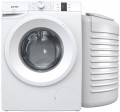Max. spin speed
Maximum drum rotation speed in spin mode. The higher it is, the more intense the spin. However, note that not all types of fabric normally tolerate high speeds — a speed
of 1000 rpm or more should be used only for especially durable fabrics, and delicate ones need to be wrung out at low speeds, so the best choice is a machine that allows you to choose the spin speed.
The maximum spin speed (
1200 rpm,
1400 rpm), in particular, determines its efficiency (see Spin class), but this parameter is not decisive — the duration of the spin cycle and the diameter of the drum also play an important role. Therefore, for machines with the same spin speed, their efficiency class may differ.
Number of programmes
When selecting a washing machine based on the number of programs, it's important to keep in mind that having 12 to 16 modes is typically sufficient. More programs, such as 25 or more, may simply offer variations of the same standard programs with different settings for duration, temperature, spin speed, etc. This may not necessarily provide a wider variety of programs. Additionally, machines with the same number of modes may have different specific sets of programs. While more modes increase the possibilities for selecting an optimal mode, it also significantly increases the cost.
Child lock
The
child lock allows you to lock the control panel so that a child cannot change the operating mode of the washing machine — stop the programme prematurely, start the machine without loading, etc.
Spin class
The quality of the machine spin mode. The spin class depends on the residual moisture content of the laundry after the end of the washing programme and is indicated by the Latin letter from
A to G, where A is the best efficiency,
B and C are good,
D, E are medium, F, G are very weak. The quality of the spin is closely related to the maximum number of revolves of the drum in this mode. Naturally, machines with better spin quality are more expensive, other things being equal.
Energy class
This parameter characterizes the efficiency of electricity consumption by the washing machine. Classes are designated in Latin letters from A to G, in ascending order of energy consumption. At the same time, in class
A there are subclasses "A+", "
A++ " and "A+++"; more pluses means less energy consumption, and the most economical option to date —
A +++ — outperforms class A by almost a third.
Machines of classes
A + and above are today considered economical, class A — medium, lower classes — high consumption. However, indicators below A are typical for semiautomatic low-cost models. As well as for units with dryers (see above) in which high energy consumption is simply inevitable.
Noise level (spin)
The maximum noise level produced by the machine during operation. Most often indicated for spinning — this is the noisiest mode of operation; for units without spinning (such as semiautomatic devices), this paragraph indicates the overall volume or the volume in the noisiest mode.
The
quieter the machine works, the more comfortable it is for others. This moment is especially critical if there are small children in the house. However, the decibel used to measure loudness is a non-linear unit, and the actual noise level is best estimated from comparative tables in special sources.
Dimensions (HxWxD)
General dimensions of the washing machine in height, width and depth.
The size of the unit determines not only the size of the space required for installation but also the ability to bring it into a particular room. At the same time, even a relatively small protruding part (like a door latch) can create problems with passing through a doorway. Therefore, in our catalogue, we try, if possible, to indicate exactly the maximum size of the machine — taking into account all the protruding parts. On the other hand, not all manufacturers provide such data. So if there is any doubt, it is worth evaluating the product by size with a certain margin. And specific information on how the dimensions were measured can usually be found in the manufacturer's documentation.
Finally, let's touch on the specifics of individual dimensions. So, in the case of front loaded machines, note that additional space in front inevitably will be required to open the door. Machines whose depth
does not exceed 40 cm are considered narrow. They can be a lifesaver in cramped conditions, especially if the design provides top loading. And a height of 120 cm or more is an almost unmistakable sign of
a machine with 2 drums which are located one above the other. It does not only increase capacity but also allows you to simultaneously wash two sets of things in different modes. The reverse side of these advantages is traditional
...— high cost.Country of origin
The country in which the washing machine was manufactured (according to the manufacturer's statement). Despite the fact that production facilities in
China are often used to assemble household appliances, specifically among washing machines there are many products assembled in Europe (
Germany,
Italy,
Poland,
Romania,
Slovakia,
Slovenia, Turkey) or in the post-Soviet space (
Belarus,
Russia,
Ukraine).
There are many stereotypes about how the build quality depends on the specific "homeland" of the device. However, most of them are not justified: the thoroughness of quality control does not depend directly on the location of production. And within individual brands, the situations in this regard can be completely opposite: relatively speaking, for one company, Polish-assembled machines can be considered more reliable than Romanian ones, and for another, vice versa. In addition, such information (about which plant a given brand has is better) often turns out to be unconfirmed rumours. In light of all this, it makes sense to pay attention to the country of production. Especially if you fundamentally want (or do
...not want) to support a certain state by purchasing products manufactured in it.
